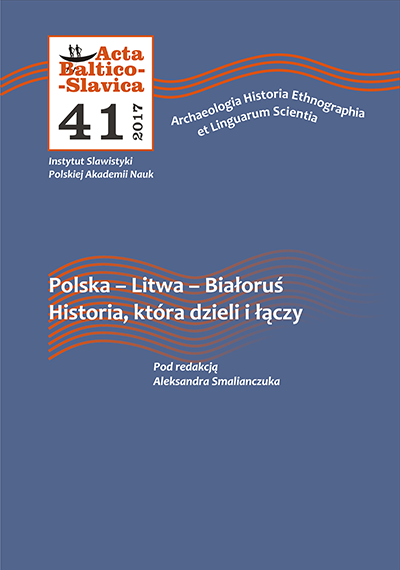Obrazy unii między Wielkim Księstwem Litewskim a Królestwem Polskim w litewskiej pamięci zbiorowej (koniec XIX w. – 1940 r.)
The images of the Grand Duchy of Lithuania and the Union of the Kingdom of Poland in Lithuanian collective memory (end of the 19th c. – 1940)
Author(s): Dangiras MačiulisSubject(s): Political history, Recent History (1900 till today), 19th Century, Politics of History/Memory, Politics and Identity
Published by: Instytut Slawistyki Polskiej Akademii Nauk
Keywords: Grand Duchy of Lithuania; Polish-Lithuanian union; collective memory;
Summary/Abstract: Since the end of the 19th century the Lithuanian national movement created several narrations about national history, which presented a negative evaluation of the Grand Duchy of Lithuania and the Union of the Kingdom of Poland. Polonization of Lithuania was highlighted as the most negative consequence of these Unions. All unions formed under the Grand Duchy of Lithuania and the Union of the Kingdom of Poland got negative evaluation in the discourse of Lithuanian nationalism. However, the Union of Lublin was considered to be the greatest harm – it was evaluated as a fatal moment in the Lithuanian history giving rise to the processes of dangerous Lithuanian national ethnic identity loss. The Lithuanian national move¬ment proclaimed cultural and political independence, and declared that the revival of historical ideal of the Unions’ national identity was unacceptable for the Lithuanian nation. When discussing the Lithuanians’ rights to political independence with the Polish public figures and reacting to ambitions of the Polish political figures to restore Poland with the Polish-Lithuanian Commonwealth national borders of 1772, in the Lithuanian press the image of two Unions (usually, the Union of Lublin) was presented as the symbol underlying the Lithuanian national political and cultural dependence. The image of the Union of Lublin was like an obligatory illustration of the Lithuanian nationalism discourse underlining the negative consequences of the union for the Lithuanian nation. It was the Union of Lublin that became the generalized image of all unions and the symbol of Lithuanian political, ethnic, cultural dependence, the memory location underlying the traumatic memory. The initiatives of the Polish public figures to actualize the memories about the unions caused the Lithuanians’ negative response and numerous discussions. A similar situation happened in 1913 when the Polish society mentioned the 500th anniversary of the Herald Union. The celebration of this anniversary was evaluated by Lithuanians as a Polish attempt to revive the political union ideal – as an attempt to make Lithuania a part of Poland. The debates of those times were used by the public figures of the Lithuanian national movement in order to emphasize the orientation of the Lithuanian national movement towards the cultural and political emancipation and underline that the Lithuanians do not accept any idea of state revival reasoned by historical unions. The image of unions in the interwar Lithuania of the 20th century was the most vivid in propagandist discourse during the fights for Lithuanian independence and when trying to restore the historical capital, Vilnius. This image was used as a rhetoric figure of propagandist discourse symbolizing the Lithuanian slavery and a threat of its dependence on Poland.
Journal: Acta Baltico Slavica
- Issue Year: 2017
- Issue No: 41
- Page Range: 156-174
- Page Count: 19
- Language: Polish

